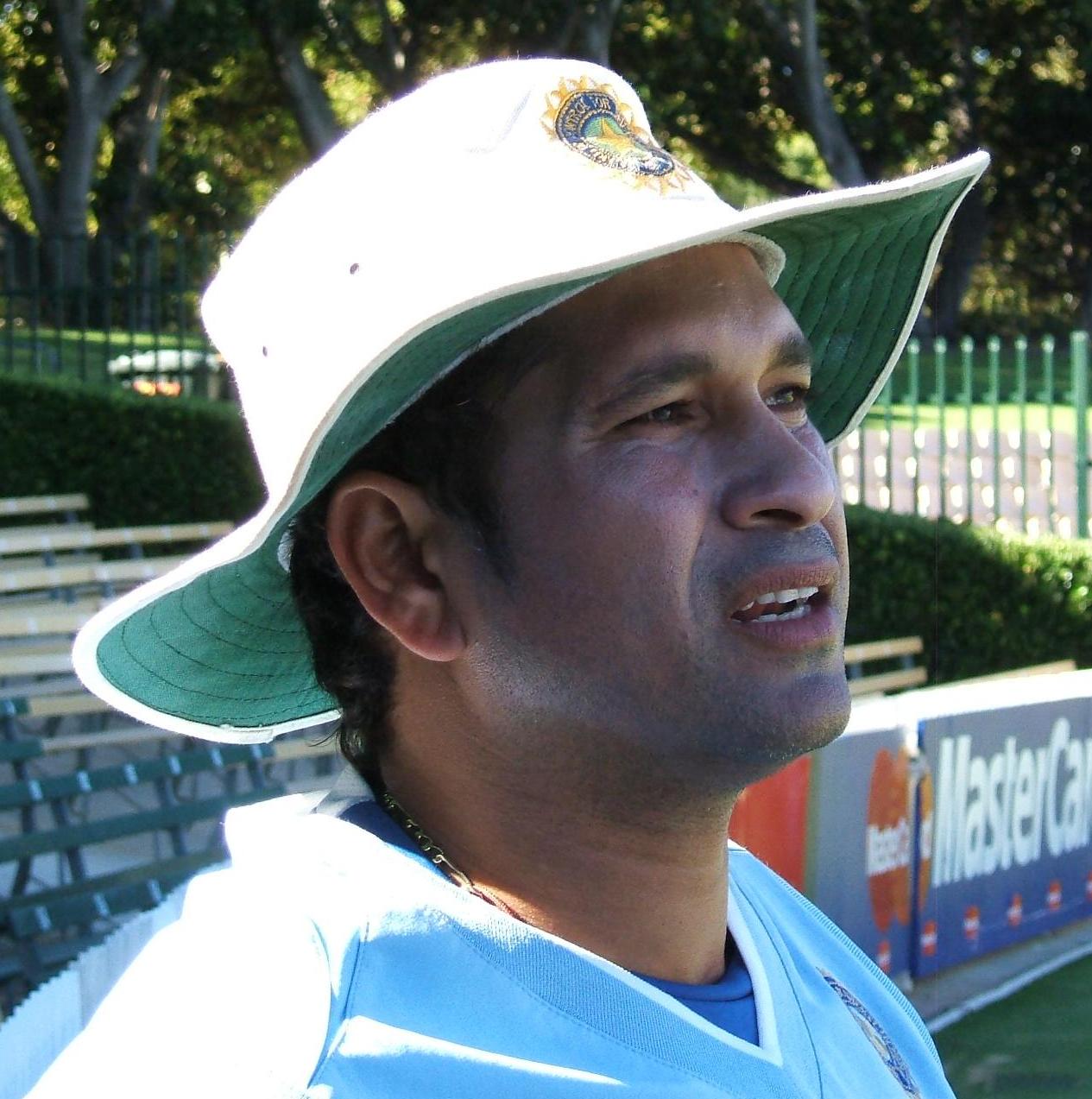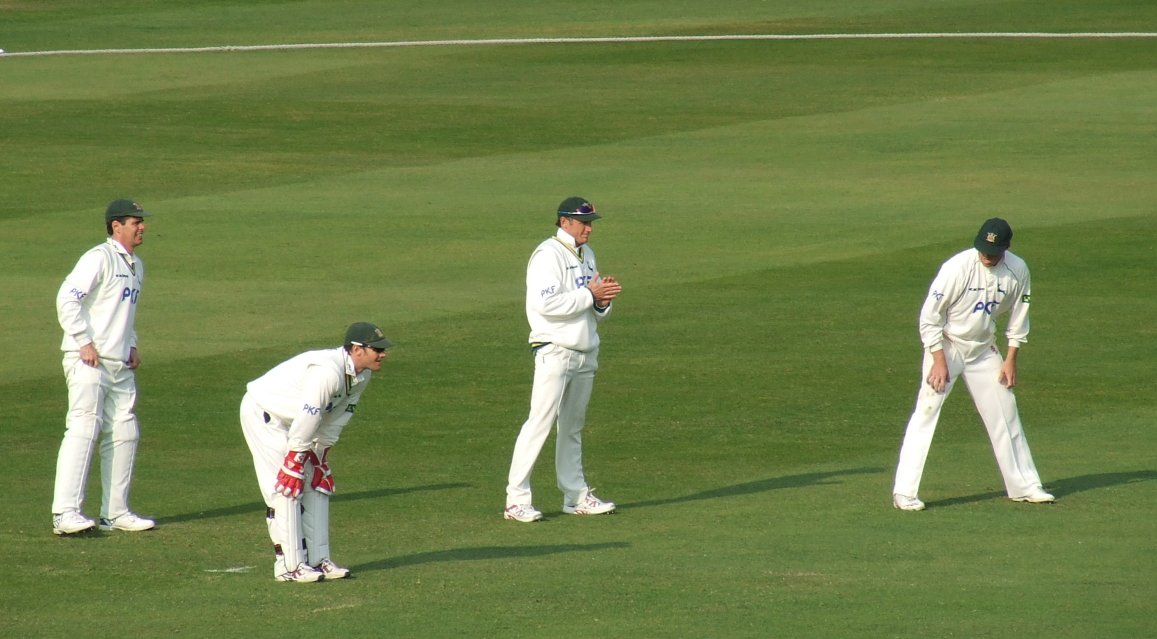|
Overthrow (cricket)
In cricket, an overthrow (sometimes called a buzzer) is an additional run scored by a batter as a result of the ball not being collected by a fielder in the centre, having been thrown in from the outfield. Overthrows usually occur when a fielder aims unsuccessfully at the stumps in an attempt to run out a batter, although sometimes they are due to handling errors by the fielder receiving the ball. Runs scored in this manner are counted in addition to any runs already scored before the fielding error took place, and are credited to the batter. If the ball reaches the boundary as a result of an overthrow then the four runs for the boundary are added to the number of completed runs before the overthrow, which can lead to the unusual event of a batter scoring more than six (or exactly five) runs off a single ball. It is considered an overthrow run if a ball hits a wicket while the batter is inside the popping crease and then the batter runs. There have been at least four instances ... [...More Info...] [...Related Items...] OR: [Wikipedia] [Google] [Baidu] |
Cricket
Cricket is a Bat-and-ball games, bat-and-ball game played between two Sports team, teams of eleven players on a cricket field, field, at the centre of which is a cricket pitch, pitch with a wicket at each end, each comprising two Bail (cricket), bails (small sticks) balanced on three stump (cricket), stumps. Two players from the Batting (cricket), batting team, the striker and nonstriker, stand in front of either wicket holding Cricket bat, bats, while one player from the Fielding (cricket), fielding team, the bowler, Bowling (cricket), bowls the Cricket ball, ball toward the striker's wicket from the opposite end of the pitch. The striker's goal is to hit the bowled ball with the bat and then switch places with the nonstriker, with the batting team scoring one Run (cricket), run for each of these swaps. Runs are also scored when the ball reaches the Boundary (cricket), boundary of the field or when the ball is bowled Illegal delivery (cricket), illegally. The fielding tea ... [...More Info...] [...Related Items...] OR: [Wikipedia] [Google] [Baidu] |
Run (cricket)
In cricket, a run is the unit of Score (sport), scoring. The team with the most runs wins in many versions of the game, and always draws at worst (see Result (cricket), result), except for some results decided by the Duckworth–Lewis–Stern method, DLS method, which is used in rain-shortened limited-overs cricket, limited-overs games when the two teams have had a different number of opportunities to score runs. One run (known as a "Single (cricket), single") is scored when the two Batting (cricket), batters (the striker and the non-striker) start off positioned at opposite ends of the Cricket pitch, pitch (which has a length of 22 yards) and then they each arrive safely at the other end of the pitch (i.e. they cross each other without being run out). There is no limit on the number of runs that may be scored off a single delivery (cricket), delivery, and depending on how long it takes the fielding team to recover the ball, the batters may run more than once. Each completed ru ... [...More Info...] [...Related Items...] OR: [Wikipedia] [Google] [Baidu] |
Batter (cricket)
In cricket, batting is the act or skill of hitting the ball with a bat to score runs and prevent the loss of one's wicket. Any player who is currently batting is, since September 2021, officially referred to as a batter regardless of whether batting is their particular area of expertise. Historically, ''batsman'' and ''batswoman'' were used, and these terms remain in widespread use. Batters have to adapt to various conditions when playing on different cricket pitches, especially in different countries; therefore, as well as having outstanding physical batting skills, top-level batters will have quick reflexes, excellent decision-making skills, and be good strategists. During an innings two members of the batting side are on the pitch at any time: the one facing the current delivery from the bowler is called the striker, while the other is the non-striker. When a batter is out, they are replaced by a teammate. This continues until the end of the innings, which in most cas ... [...More Info...] [...Related Items...] OR: [Wikipedia] [Google] [Baidu] |
Fielding (cricket)
Fielding in the sport of cricket is the action of fielders in collecting the ball after it is struck by the striking batter, to limit the number of runs that the striker scores and/or to get a batter out by either catching a hit ball before it bounces, or by running out either batter before they can complete their current run. There are a number of recognised fielding positions and they can be categorised into the offside and leg side of the field. Fielding also involves trying to prevent the ball from making a boundary where four "runs" are awarded for reaching the perimeter and six for crossing it without touching the grass. A fielder may field the ball with any part of their body. However, if, while the ball is in play, he/she wilfully fields it otherwise (e.g. by using their hat) the ball becomes dead and five penalty runs are awarded to the batting side, unless the ball previously struck a batter not attempting to hit or avoid the ball. Most of the rules cover ... [...More Info...] [...Related Items...] OR: [Wikipedia] [Google] [Baidu] |
Outfield
The outfield, in cricket, baseball and softball is the area of the field of play further from the batsman or batter than the infield. In association football, the outfield players are positioned outside the goal area. In bat and ball games In baseball, softball and cricket, fielders in the outfield have more ground to cover than infielders, but also more time before the ball reaches them. Catches are most likely to arise from shots that have been 'skied' (in cricket) or 'popped ' (in baseball and softball). If a catch is not possible (for example, the ball has bounced, or is rolling or skidding across the turf) the fielder will attempt to head off, pick up and throw in the ball as quickly as possible to reduce the distance the runners can run and hopefully to effect a run out (cricket) or tag out (baseball and softball). In cricket, where the ball is far more likely to stay low against the ground than in baseball or softball, the condition of the turf has a major effect ... [...More Info...] [...Related Items...] OR: [Wikipedia] [Google] [Baidu] |
Stumps
In cricket, the stumps are the three vertical posts that support the bails and form the wicket. '' Stumping'' or ''being stumped'' is a method of dismissing a batsman. The umpire ''calling stumps'' means the play is over for the day. Part of the wicket The stumps are three vertical posts which support two bails. The stumps and bails are usually made of wood, most commonly ash, and together form a wicket at each end of the pitch. The overall width of each wicket is 9 inches (22.9 cm). Each stump is 28 inches (71.1 cm) tall with maximum and minimum diameters of 1 inches (3.81 cm) and 1 inches (3.49 cm). They have a spike at one end for inserting into the ground, and the other end has a U-shaped 'through groove' to provide a resting place for the bails. In junior cricket the items have lesser dimensions. Each stump is referred to by a specific name: * Off stump is the stump on the off side of the wicket (the same side as the batsman's bat). * ... [...More Info...] [...Related Items...] OR: [Wikipedia] [Google] [Baidu] |
Run Out
Run out is a method of dismissal in cricket, in which the fielding team put down the wicket of a batter who is outside their ground, usually because they are trying to score a run. Run out is governed by Law 38 of the laws of cricket. If the batter is judged run out, the run does not count and the bowler does not get credit for the wicket. A run out can also be effected when the batters are not attempting a run if one of them leaves the crease when the ball is not dead. Some such dismissals cause controversy because they challenge long-established — but not universal — conventions about the spirit of the game. Definition A batter is run out if, at any time while the ball is in play, no part of their bat or person is grounded behind the popping crease and their wicket is fairly broken by the action of a fielder. The batter whose ground is at the end where the wicket is broken is out. A batter can be run out even when not attempting a run if they are out of ... [...More Info...] [...Related Items...] OR: [Wikipedia] [Google] [Baidu] |
Boundary (cricket)
In cricket, the boundary is the perimeter of a playing field. It is also the term given to a scoring shot where the ball is hit to, or beyond, that perimeter, which generally earns four or six runs for the batting team. Briefly, if the ball is struck by the batter and rolls or bounces over the boundary (or just touches it) it is known as a "four", and scores four runs, whereas if it flies over (or touches) the boundary, without touching the ground before that, it is called a "six", and scores six runs. There are rules covering every possible situation, including the fairly common one when a fielder is in the air beyond the boundary when he or she catches or strikes the ball with his or her hand or another part of the body. Edge of the field The boundary is the edge of the playing field, or the physical object (often a rope) marking the edge of the field. In low-level matches, a series of plastic cones or flags are sometimes used. Since the early 2000s, the boundaries at prof ... [...More Info...] [...Related Items...] OR: [Wikipedia] [Google] [Baidu] |
Test Cricket
Test cricket is a Forms of cricket, format of the sport of cricket, considered the game’s most prestigious and traditional form. Often referred to as the "ultimate test" of a cricketer's skill, endurance, and temperament, it is a format of international cricket where two teams in white clothing, each representing a country, compete over a match that can last up to five days. It consists of four innings (two per team), with a minimum of ninety Over (cricket), overs scheduled to be bowled per day, making it the sport with the longest playing time. A team wins the match by outscoring the opposition in the Batting (cricket), batting or bowl out in Bowling (cricket), bowling, otherwise the match ends in a Result (cricket), draw. It is contested by 12 teams which are the List of International Cricket Council members, full-members of the International Cricket Council (ICC). The term "test match" was originally coined in 1861–62 but in a different context. Test cricket did not beco ... [...More Info...] [...Related Items...] OR: [Wikipedia] [Google] [Baidu] |
Andrew Symonds
Andrew Symonds (9 June 1975 – 14 May 2022) was an Australian international cricketer, who played all three formats as a batting all-rounder. Commonly nicknamed "Roy", he was a key member of two Cricket World Cup, World Cup–winning squads. Symonds was a part of the team that won both the 2003 Cricket World Cup and, four years later, the 2007 Cricket World Cup. Symonds played as a right-handed, middle-order batsman and alternated between medium pace and off-spin bowling. He was also notable for his exceptional fielding skills. After mid-2008, Symonds spent significant time out of the team due to disciplinary reasons, including alcohol abuse. In June 2009, he was sent home from the 2009 World Twenty20, his third suspension, expulsion or exclusion from selection in the space of a year. His central contract was then withdrawn, and many cricket analysts speculated that the Australian administrators would no longer tolerate him and that Symonds might announce his retirement. Symon ... [...More Info...] [...Related Items...] OR: [Wikipedia] [Google] [Baidu] |
Australia Cricket Team
The Australia men's national cricket team represents Australia in international cricket. Along with England, it is the joint oldest team in Test cricket history, playing and winning the first ever Test match in 1877; the team also plays One-Day International and Twenty20 International cricket, participating in both the first ODI, against England in the 1970–71 season and the first T20I, against New Zealand in the 2004–05 season, winning both games. The team draws its players from teams playing in the Australian domestic competitions – the Sheffield Shield, the Australian domestic limited-overs cricket tournament and the Big Bash League. Australia are the current ICC Cricket World Cup champions. They are often regarded as the most successful national team in the history of cricket. The national team has played 875 Test matches, winning 419, losing 234, 219 drawn and with 2 tied , Australia is first in the ICC Test Rankings. Australia is the most successful team in T ... [...More Info...] [...Related Items...] OR: [Wikipedia] [Google] [Baidu] |
New Zealand Cricket Team
The New Zealand national cricket team represents New Zealand in men's international cricket. Nicknamed the Black Caps (), they played their first Test in 1930 against England in Christchurch, becoming the fifth country to play Test cricket. From 1930 New Zealand had to wait until 1956, more than 26 years, for its first Test victory, against the West Indies at Eden Park in Auckland. They played their first ODI in the 1972–73 season against Pakistan in Christchurch. New Zealand are the inaugural champions of ICC World Test Championship which they won in 2021 and they have also won ICC Champions Trophy in 2000. They have played in the ICC Cricket World Cup final twice in 2015 and 2019 but are yet to win one, although they are recognized as one of the best teams of the tournament. They have also played the final of the ICC T20 World Cup in 2021 and failed to win it too. Tom Latham is the current captain of the team in Test cricket and Mitchell Santner is the current c ... [...More Info...] [...Related Items...] OR: [Wikipedia] [Google] [Baidu] |









